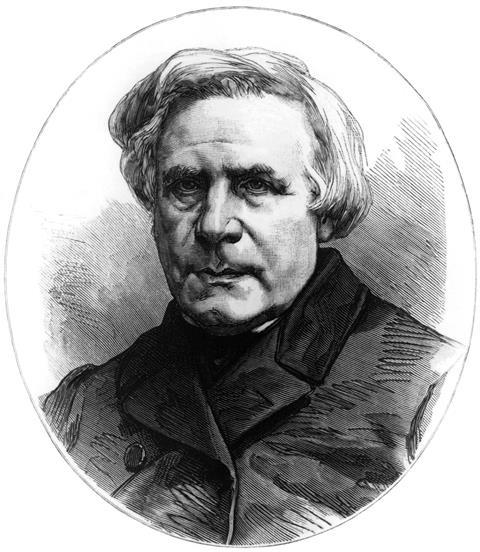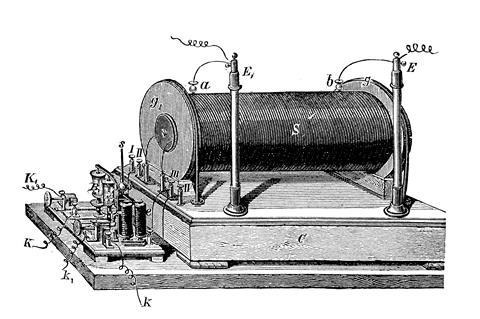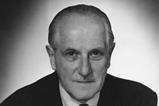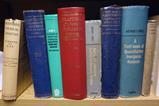The source of a hum since silenced in the laboratory

A few years ago, I heard a radio programme in which a set of panellists tried to identify a city from a few seconds of street sound. It was an enthralling puzzle, where clues might be gleaned from the cries of street traders, the songs of birds, snatches of music, and the odd bark or bray.
But it made me wonder: if you could listen to the soundscape of a lab of the past, could you date it? There are sounds in our labs that are, to all intents and purposes, gone forever. Among them is the rattle of the Sprengel mercury drop pump, the hiss and whirr of the air-driven mechanical stirrer and the hum or sing of the induction coil, a device that ushered in modern physics.
The story of the coil began silently, in 1820, with the mysterious twitch of a compass needle when Hans Christian Ørsted passed an electric current through a nearby wire. The needle flipped round when the current was reversed. Unbeknown to Ørsted, the Italian scientist Gian Domenico Romagnosi had observed this almost 20 years earlier but had been ignored.
After reading the report, Michael Faraday began to explore its weirdness. In a series of methodical experiments he established that current, magnetic field and motion were linked. In particular, motion across, or a change in, the magnetic field led to a current being induced in the wire. Faraday had established a new way of generating electrical currents. Further experiments by André-Marie Ampère and others showed that coils of wire, connected to a battery, became magnetised, especially when wrapped around an iron core.
Across Europe, experimenters began to play with these new ideas. One of these, Nicholas Callan, was an Irish priest who was educated at the Maynooth Seminary in Ireland. While in Rome studying divinity in the 1820s he learned of Alessandro Volta’s and Luigi Galvani’s experiments with electricity, which fascinated him.
While still in his twenties, Callan was appointed to teach natural philosophy at Maynooth. A man of huge energy, he put together a general course in science that would survive well into the 20th century. He also began to do experiments.
It’s a knockout
His electromagnets – one of which was almost two metres long – consisted of a thick copper wire wrapped around a horseshoe-shaped core of iron. It proved capable of lifting a weight of two tonnes. After reading about how a copper ribbon near such an electromagnet could deliver a shock, Callan began experiments with two concentric cylindrical coils. By interrupting the current through the inner coil, he could produce electrical shocks from the outer. He used his students for these experiments – one, who was rumoured to have been knocked unconscious by one of these jolts, would later become Archbishop of Dublin.
Crucial to the operation of the coil was the speed at which the circuit was broken and re-established. Callan developed an ‘interruptor’ switch based on the escapement of a long-case clock that caused two brass pins to dip alternately in and out of two pots of mercury, reversing the current flow through the coil. With a long enough outer coil he could even strike an arc between two carbon rods, an invention he exhibited in London in 1838.

In 1851, a Prussian instrument maker, Daniel Ruhmkorff, patented a much more effective and compact version of the Callan device. Ruhmkorff seems to have spent time working in London. But in 1855 he set up a shop in Paris specialising in electrical equipment – and his new induction coil in particular. It consisted of a cylindrical iron rod around which he wound a primary coil of between 10 and 100 turns of fairly thick copper wire, insulated with shellac or with silk. Around this he wound miles of slender wire linked, through a ‘condenser’ (a capacitor to store the charge), to a mechanical interruptor: an iron plate on a spring that would break the circuit each time the iron core was magnetised. Depending on stiffness the interruptor could be made to vibrate at high frequency, giving rise to a hum. With two electrodes mounted beside the coil, sparks a foot long might fly.
Ruhmkorff’s device was an instant hit and Callan was quickly forgotten. Ever-better designs of Ruhmkorff coils would soon power colourful Geissler tubes. Improvements in vacuum technology made the study of the mysterious cathode rays possible, eventually leading to the discovery of the electron. Heinrich Hertz’s discovery of radio waves was made from the sparks of an induction coil, and at the end of the century, x-rays too.
Ruhmkorff died in 1877, having won many awards, while Callan is largely forgotten. The coils themselves, and their humming interrupters, have vanished into the collections of museums and enthusiasts. As you think back to your time in the lab, what is the sound you would miss the most if it vanished forever?

















No comments yet